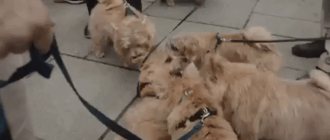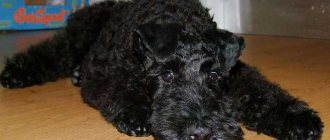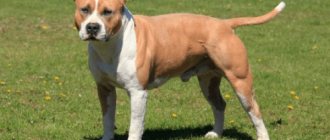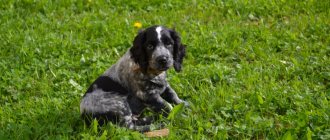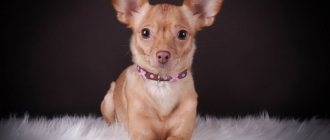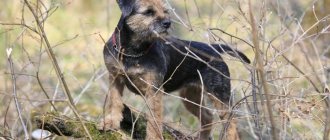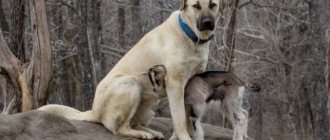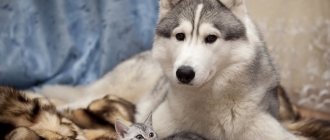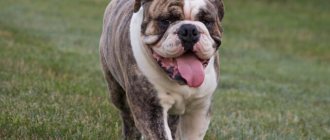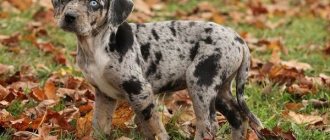| Type |
|
| Size | large (26-50kg) |
| Main features |
|
| Included in |
|
| Intelligence | 80% |
History of the Black Russian Terrier breed
Black Russian Terrier
The Black Russian Terrier is one of the few domestic breeds, the breeding of which did not occur spontaneously, but by order of the government. In the mid-40s, the Soviet kennel “Krasnaya Zvezda” was tasked with breeding a type of service dog capable of working productively in extreme weather conditions. The initiator of the experiment was the “father of nations” himself, hence the alternative name – “Stalin’s dog”.
It did not take much time to create the ideal four-legged guard, which cannot be said about the number of animals that took part in the crossing. According to some reports, about 17 breeds donated their genes to Russian Black Terriers, including the Airedale Terrier, Newfoundland, East European Shepherd, Giant Schnauzer, Great Dane and Rottweiler.
Soviet breeders met the first representatives of the black terrier clan already in 1957, at the All-Union Exhibition. A year later, RCT (the abbreviated name of the breed) created its own standard of appearance. In the late 70s, the Blacks began to expand the boundaries of their own popularity, gradually moving to Europe and the American continent. As a result, they were recognized by the FCI in 1983. As for the USA specifically, where the “Red Star” wards made a splash, the first club of breed lovers appeared there back in 1993. But the AKC (American Kennel Club) persisted for another 11 long years, registering black terriers as a separate type of protective guard dog only in 2004.
History of the origin of the species
Stalin's dog was first bred for the Russian army at the end of World War II. This breed can work in harsh climate conditions: heat and cold. Three breeds were used to breed it: the huge schnauzer, the Newfoundland and the Airedale terrier.
Black terriers were highly valued in Russia not only as highly skilled and courageous service dogs, but also as loyal and devoted pets.
These dogs were used by the Red Army to track down fugitives.
Appearance of the Black Russian Terrier
Black Russian Terrier puppy with mom
The Black Russian Terrier is a charismatic, mustachioed athlete, dressed in a glossy black, two-layer “fur coat.” The height of this brutal ranges from 72-76 cm (for males), and the weight can reach 60 kg. Bitches are more graceful than “boys”, but they are also far from babies. The average RCT “girl” weighs from 42 to 50 kg, and this is with a height of 68-72 cm. The breed’s signature features are a long mustache made of wool and shaggy bangs that fall over the eyes, which make the dog look very impressive, if not menacing .
It is worth noting that modern blacks are very different from the RCT of the 50s. The exterior of the animals has become more refined (the fur of the individuals presented at the All-Russian Agricultural Exhibition was noticeably shorter and denser), and their temperament has become more stable. Severe aggressiveness and increased suspiciousness left the breed along with the first generations of dogs, around the 80s. At the same time, from the moment of announcement to this day, work continues to improve the phenotype of the black terrier, since babies periodically “slip through” litters that look very much like their own ancestors, that is, Airedale terriers, Giant Schnauzers and Newfoundlands.
Head
Massive, proportional to the dog’s body. The skull is elongated, of good width, with a flat frontal part. In general, the head of the Black Russian Terrier is not particularly prominent, and the brow ridges, stop, and occipital area of representatives of this breed are not very sharply defined. The muzzle of all RCTs is strong, wide and relatively short.
Teeth and jaws
Curly back of a black terrier
The dog's strong teeth stand close to each other. The jaws are closed in a scissor bite.
Ears
Triangular type, dense, with the leading edge tightly fitting to the dog's head. Ear type – hanging, ear size – medium.
Eyes
Small, widely set, oval shaped. The eyelids of the Black Russian Terrier are black, dry, and fit tightly to the eyeball.
Nose
The lobe is black and large.
Neck
Very dry, but muscular, with a well-defined scruff.
Muzzle of a black Russian terrier
Frame
Representatives of the Black Russian Terrier breed are characterized by a strong, voluminous body with a straight back, complemented by prominent withers and a wide, short loin. The chest of the RCT is deep, elongated oval in shape, with slightly convex ribs. The stomach is slightly tucked and reaches almost to the level of the elbows.
Limbs
All Black Russian Terriers have straight legs, long, noticeably set back shoulder blades, and wide, fleshy hips. The elbows of representatives of this clan are pressed tightly to the body, and the short and massive metacarpus stand at a slight angle. The dog's front paws are noticeably larger than the hind paws and more rounded in shape. At the same time, the pads and claws on both the front and hind limbs have the same color - black.
Tail
Tail of a Black Russian Terrier
Saber-shaped, with a thickened base. In Russia, black Russian terriers usually have their tails docked. At the same time, the natural length of this part of the body is not considered a disadvantage.
Wool
Ideally, a black terrier should have a thick double coat: a hard guard 5 to 15 cm long + a dense undercoat. The dog's muzzle should be richly decorated with wavy hair, forming a lush mustache, a neat beard and shaggy eyebrows.
Color
Everything is simple here: only black color and no more variations. The only exception is a slight gray “patina” on no more than ⅓ of the blackling’s body.
Disadvantages and disqualifying defects of the breed
Flying gait
Minor deviations from the breed standard do not affect show karma, unless their number is too large. But with more serious defects such as a small chest, a squirrel tail, a too short head or light-colored eyes, an animal can at most be classified as “good”, but not “excellent”. If we talk about disqualification, then black Russian terriers who have:
- too obvious similarity with ancestral breeds (Giant Schnauzer, Newfoundland, Airedale Terrier);
- depigmented nose;
- malocclusion;
- eyesore or eyes of different colors;
- white markings on fur;
- straight wool;
- spots of gray “patina” with a distinct outline.
Animals that lack decorative hair on their heads and legs, as well as dogs with too unstable psyches and behavioral disorders, will also not be allowed to exhibit.
Distinctive features
The main distinguishing features of the Black Russian Terrier are:
- The head is proportional to the body. It is equal to the length of the neck and at least 40% of the height of the dog at the withers.
- The eyes are oval, medium in size, dark and relatively widely spaced.
- The ears are medium in size, triangular in shape, high, but not higher than the level of the skull. The skin of the ear is dense, rounded towards the bottom, hanging with the leading edge on the head.
- The muzzle is wide with a slight narrowing towards the nose. The mustache and beard emphasize the volume and give it a square shape.
- The nose is large and black.
- bite . The teeth are large and white. The incisors form a straight line at the base.
- The neck is muscular and powerful. The length is the same as the length of the head.
- The body gives the impression of an oval sternum with wide and well-proportioned ribs.
- The tail is thick, set moderately high and at 45 degrees horizontally. The shape resembles a sickle or saber.
- Color only black.
Until 2007, in all countries of the world the tail of the black Russian terrier was docked; now this procedure is prohibited.
Photo of a black Russian terrier
Diet
Despite the fact that the RCT is a predator by nature, the animal’s diet should not consist exclusively of meat, just as it is impossible to feed the dog only porridge with meat broth. If you prefer natural nutrition for your four-legged friend to ready-made food, a balanced diet for him will include:
- lean meat, raw or cooked;
- porridge;
- bread (maximum 2 times a week);
- sea fish;
- seasonal vegetables and fruits;
- dairy products.
Mixing dry food with home cooking is highly discouraged, so it is important to decide right away what kind of food your pet will have. This prohibition is due to the fact that different stomach receptors are used to digest feed and natural food, as a result of which the dog may suffer from indigestion. Prohibited products are:
- chocolate;
- any snacks, fast food;
- smoked meats;
- spices, marinades.
Personality of the Black Russian Terrier
Curious by nature
, the Black Russian Terrier is a bodyguard, a watchman, and a devoted friend at the same time. Despite their professional qualifications, these serious “barbels” relatively quickly adapt to the role of family pets, easily establishing contact even with small children. Suspicion and distrust of strangers - qualities that, by definition, any service breed should have - are manifested in black terriers to a sufficient extent, although not as clearly as in their ancestors who lived in the 50s and 60s. At the same time, they do not start with a half-turn, preferring to once again verify the reality of the threat.
Animals will only risk attacking an enemy when they feel that he is encroaching on the safety of their owner. Moreover, they will never tear the jacket or skin of the aggressor until victory. Their task is to put the attacker to flight, and not to cause him serious injury. The little black one will not greet guests who accidentally look at the light with a dissatisfied grumble (provided that it is raised correctly), but it will also not joyfully jump around them, demanding attention and affection. These shaggy bodyguards have an extremely limited supply of love and tenderness, so the dog prefers to spend it on members of the family in which he lives, but not on casual acquaintances.
Let me hug you!
Russian black terriers diligently guard their master's property. For example, you can leave not only a house, but also an entire estate to these responsible “jocks” without any fear. Rest assured, the animal will not be too lazy to explore every corner of the territory entrusted to it and will not allow a single living soul to enter it. There is an opinion that Russian black terriers have a vindictive and ferocious character. Indeed, the memory of this breed is phenomenal, but this does not mean that its representatives only remember the harm caused to them. The pet will also never forget pleasant moments and the owner’s kindness. By the way, about kindness. In everyday life, RCTs are very proud, which does not prevent them from respecting and sincerely loving their owner. The main thing is not to go too far and not try to train a black terrier to be a bearer of the master's slippers, thereby degrading his working qualities.
In general, today's blackies are quite calm and serious pets who will play with children and happily run after their owner's bicycle. In addition, they are smart enough to understand the owner’s mood by intonation and facial expressions. If the latter is not in good spirits, the Black Russian Terrier will never impose his company on him and will go about his own business. “bearded campaigners” are quite capable of getting along with other dogs. True, only if they do not see them as rivals. Therefore, if you are going to keep two “tails” in your family, then it is best that one of them is a representative of a decorative breed.
Features of character and behavior
The Black Russian Terrier has a very calm, confident and safe character. He is extremely friendly and outgoing towards his family, but is aloof and distrustful of strangers due to his natural protective instinct. This breed is very good with children and is very trainable. Black Terriers do not suffer from separation anxiety, making them an ideal watchdog.
Black Russian Terriers form strong bonds with their owners and always try to please them. However, for proper training, it is necessary to indicate to the dog who is dominant in the house. This breed is very energetic and is well suited for people with an active lifestyle. In addition, they are well suited for guarding the house and hunting wild animals. At the same time, they do not conflict and do not behave aggressively towards other pets.
Black Russian Terriers are very playful, so they need long walks.
Advantages
The main advantages of this breed include:
- Strong and robust physique;
- Big sizes;
- Harmonious physique;
- Good health;
- Easy to care for;
- Mind;
- Lack of aggression towards children and other pets;
- Wary of strangers;
- Adaptability to heat or cold;
- No seasonal shedding.
Flaws
Along with the advantages, there are also disadvantages, which include:
- The coat requires constant trimming and combing;
- Puppies under 1 year of age require careful and strict training;
- Not suitable for beginners;
- An adult dog needs long and hard training.
Training and education
We are listening to you carefully
Service dogs are always a burden of responsibility, especially since others perceive such animals as potential killers and treat them without much sympathy. Take a professional approach to raising your pet or, if this is the first dog in your life, entrust this matter to a specialist. Remember, from a Black Russian Terrier puppy you can mold both a calm children's nanny and a vigilant guard - it all depends on who exactly you want to see in him and what training method you prefer.
The leadership habits of black dogs have not been canceled, so do not trust their training to children or elderly people, in whom the dog sees a “lower caste”. The Russian Black Terrier needs a strict but fair mentor who respects the dignity of the animal, but does not forget about himself. In general, Black Russian Terriers make diligent students, if the peculiarities of their temperament and psychology are taken into account. So, for example, in the case of this breed, multiple repetitions will not work. The animal will follow the command and go through the obstacle course once or twice, after which it will stop any actions. And the point here is not so much in stubbornness, but in the self-esteem of a dog that does not want to play in public. Don't be annoyed if your pet thinks for too long before executing a command. Measure seven times and cut once - this is just about blackies.
Important: Black Russian Terriers can be trained both as puppies and as adults, but in the second case the process will be more difficult. In addition, it is important to immediately choose the right technique, since it will not be possible to correct mistakes made during training. RCTs are not retrained in principle.
Black Russian Terrier watching the surroundings
The youth of the breed should not be discounted. The Black Russian Terrier family is still developing and improving, so among the dogs there may be individuals with completely different learning abilities. For example, animals in which the genes of shepherds and Rottweilers predominate are better suited to the role of bodyguards. Individuals who have inherited the character of Airedale Terriers are more cunning and friendly, so they make ideal companions.
Like most puppies, young blackies are very playful and restless, which is fraught with inevitable destruction in their homes. From the first days of your baby's arrival in the house, curb his violent temper by finding alternative activities for him. For example, buy more rubber squeaks for your puppy, keep him busy with bones and other safe objects.
What not to do
- Abuse the commands “Ugh!”, “No!”, turning your pet’s life into one continuous ban.
- Encourage your puppy to play until he starts biting.
- Play tug-of-war with a baby or teenager whose bite has not yet fully developed.
- It is rude to take away objects that have been damaged by a dog and use physical violence against it.
Black Russian Terrier
How to care for your blackie
Thanks to the almost ideal character of terriers (if they are raised correctly), the dog behaves well with other animals and small children, and reliably protects the family and the house in which it lives. In addition, this breed is unpretentious in living conditions and care. Black terriers are easily adaptable, so they can live both in a private house and in an apartment. Caring for a pet does not require any specific skills and consists of the following:
- Wool. Black terriers need to be washed and combed regularly, but you will have to deal with your pet’s dissatisfaction, since they do not really like water treatments. Accustom your animal to bathing once every 2 weeks from childhood, then he will tolerate it more calmly. In addition, pets need regular haircuts; hair should be shortened when the blackie is six months old.
- Eyes ears. These organs need regular inspection and cleansing with a swab moistened with water.
- Teeth. To prevent the formation of tartar, your dog's diet should include solid food. Blackies need to brush their teeth with a special toothpaste 1-2 times a week.
- Paws. Nail trimming occurs once every 2 months. After each walk, the paw pads should be inspected for stuck fragments and pebbles. The fur between the toes must be trimmed, as tangles may appear there and cause discomfort when walking.
Early socialization and adaptation
Experienced breeders recommend introducing the puppy to the outside world as early as possible, otherwise the animal may react inappropriately to strangers and animals. The first commands for the little one should be “near”, “to me” and “sit”. Thanks to the dog’s knowledge of such actions, walks will be as calm as possible, and surrounding people and dogs will be safe.
Grooming
Some owners of black Russian terriers complain that their pets' coat becomes too coarse and fades. To maintain the beautiful appearance of your dog’s coat, you need to follow certain rules:
- do not leave the animal for a long time in the open sun (under the influence of UV rays, the fur will lose its rich color and may acquire a brown tint);
- do not use a hairdryer after bathing, because under the influence of high temperatures, gray hairs appear on the fur coat, and the fur itself becomes overdried and brittle;
- monitor the humidity of the room in which the little blackie lives (over-dried air causes brittleness of the pet’s hair);
- for bathing you need to use warm water, since too high a temperature will cause the coat to fade;
- You need to comb the animal with a medium-hard brush and only after the fur has completely dried, otherwise the ends of the hair may become split;
- Be sure to provide your dog with a balanced diet.
Features of grooming
The need to groom Stalin's dog depends on its class (pet or show), as well as the quality of its coat. Some individuals have coarser guard hair, while others have it combined with a soft undercoat. There are other blackies whose undercoat is soft, long, and dominates the outer coat. Grooming for pets with the first type of coat involves annual shaving of the hair from the body and hips; other representatives of the breed require more careful care and frequent combing. Grooming black dogs is done as follows:
- the wool is pre-cleaned and combed well;
- the mustache and beard are trimmed on the dog’s head, smooth transitions from short- to long-cropped hair are formed;
- The body and limbs are cut strictly in accordance with the standard.
Care and maintenance
It’s good if, before buying a black terrier puppy, you managed to acquire a country mansion with a plot of land for a full-fledged walk for your pet. If this does not happen, then you can also experiment with keeping “Stalin’s dog” in a city apartment, but you will have to spend much more effort. Firstly, because Russian RCTs bark quite loudly, which, of course, your housemates will not like. The way out of the problem: seriously engage in training and curbing the “vocal talents” of your pet. Secondly, the Black Russian Terrier is an exclusively working breed, and life is not easy for her without physical activity, so she will have to walk her apartment dwellers more often and for longer.
RCTs living in private houses can be placed in a booth or enclosure, since these shaggy guards are accustomed to low temperatures. But in the autumn-winter period, the dog house will have to be thoroughly insulated. By the way, putting an animal in an enclosure for a day, or even several days, is real barbarity. Even a little blackie living in the yard and having the opportunity to warm up a little still needs a good stretch on the sports ground or in the field.
Hygiene
Black Russian Terrier with his owner
Have you already read on online forums that the breed does not shed? Now forget about it, because in fact, seasonal “hair loss” does occur in Black Russian Terriers. Yes, the RCT’s fur does not shed, but rather falls into tangles, but you still have to take care of it in order to maintain your pet’s spectacular appearance.
Experts recommend brushing your dog every day, and removing matted hair and giving the animal a superficial trim a couple of times a month. However, there are some nuances here too. In particular, among this breed there are both individuals with hard and soft hair, and they are cared for differently. Wire-haired blackies are less problematic in terms of care. Their hair does not fall off and get tangled so actively, so you don’t need to be on duty with a comb and a tangle cutter. For dogs with soft fur, the situation is exactly the opposite: if they are not brushed daily and their tangles are not trimmed in a timely manner, they quickly lose their luster.
A few words about the “bangs” of the black terrier. Ignorant dog lovers often comment on the fact that long hair on an animal’s forehead interferes with its vision. Moreover, according to the same theory, wool gathered in a ponytail is also not a panacea. Allegedly, after such a procedure the dog will certainly go blind. In fact, you can remove your pet's decorative hair any way you want or even braid it. This fact will not affect visual acuity in any way. Nobody forbids leaving the bangs falling over the dog’s eyes either. Believe me, the black terrier will definitely see what he needs through his thick strands.
It is recommended to bathe RCT in cases where the dog’s coat is thoroughly dirty, which often happens with regularly walked dogs. Wash the dog using zoo shampoo, which can be replaced with “human” products for dry and brittle hair, diluted in water. The final stage of washing is applying conditioner or rinsing the wool in a vinegar solution (1 tablespoon of vinegar per liter of water). To prevent your Black Russian Terrier's hair from becoming dry and rough, never blow-dry it or comb it immediately after bathing. Exposing an animal to the sun too often also affects the condition of its coat, so if the dog lives in an enclosure, build a canopy for it for the summer, under which it could hide from the heat.
Black Russian Terrier Grooming
Typically, salon haircuts are given to show-class individuals, but pets can have their fur shortened on their own. To do this, buy hairdressing and thinning scissors, a stainless steel comb and a slicker brush. You can also purchase a special wool machine, which makes cutting faster.
Cropped Black Russian Terrier with docked tail
Do not remove too much hair from the blackie's body, as representatives of this breed love to scratch themselves. The dense undercoat serves as a protective layer that protects the dog’s skin from its own claws, and if it is shortened too much, wounds on the body are inevitable, so the ideal length of hair on the body is 1.5 cm. The same rule applies to the ears, on which it is necessary to leave from 6 to 12 mm wool. If the bangs and mustache of the Black Russian Terrier are shortened, it is only slightly, as this distorts the appearance of the breed. In addition, hair grows very slowly in these areas of the body. It is best to cut only the head, not reaching 2-3 cm from the brow ridges. Between the eyes, you can also cut a regular triangle that goes to the bridge of the nose, which will make your pet’s appearance more advantageous.
On the forelimbs and metatarsals the hair is left longer than on the body. The same is done with the hair on the legs and thighs, which is simply neatly trimmed. But the tufts of hair between the fingers must be carefully cut, since they are the main “garbage collectors”. For hygienic purposes, the abdominal area, groin area and area around the anus are also cut shorter.
Walk
The Black Russian Terrier needs to be walked a lot and productively, this is especially true for apartment dwellers who lack physical activity. Until the puppy has had its first vaccination, walks should be short but frequent. Individuals who have been vaccinated can be taken on longer promenades. The optimal walking time for a one-year-old terrier is 1 hour, and you will have to go outside with the dog at least three times a day. By the age of one and a half years, the blackie can be transferred to a two-time walk.
Since during regular excursions around the city or park your pet will not have time to let off steam, it is better to additionally load it with physical exercises. For example, you can practice agility with your dog or make him run after your bike. It is very useful to create artificial difficulties for the dog. For example, invite her to run on loose, falling snow, or a sandy beach. Such entertainment takes a lot of energy from the animal, while simultaneously training its endurance.
Don’t forget: in places where people are likely to appear, Black Russian Terriers are only walked on a leash and with a muzzle.
Feeding
Black terriers also love autumn photos in the leaves
Black terriers are natural meat eaters. Of course, the dog’s body also successfully breaks down plant proteins, but you are unlikely to be able to turn your blackie into a porridge and carrot lover. Meat should make up at least half, and preferably ⅔, of the animal’s diet, but there are no requirements for its quality. The black terrier will gobble up stringy scraps of horse meat, old beef or a weathered rabbit with the same pleasure as a first-class tenderloin.
To save money, meat can be replaced with offal, which dogs also adore. But you will have to be careful with sea fish, because, for example, excessive consumption of pollock, haddock, blue whiting, whiting and whiting can cause anemia in your pet. It is better to cook porridge from several types of cereals so that the blackie’s body receives all the necessary microelements in one serving. As for pasta and other flour products, it is better not to give them at all, although black terriers will almost sell their souls for them. But as a compromise, a piece of stale or dried rye bread will do. In addition, the black terrier's diet should include seasonal fruits and vegetables (cuts, juices, purees), fresh herbs, low-fat sour milk and eggs.
It is better to feed your four-legged friend from a stand, forming his correct posture. After eating, dogs' whiskers and beard usually become clogged with crumbs, so after each meal, the muzzle must be wiped or even washed. In addition, most blacklings are incredible water drinkers, which is why the hair on their lower jaw constantly gets wet. If you do not pay attention to this factor, then over time a fungus will develop in the beard of the Black Russian Terrier, so if you notice drops falling from your pet’s chin, do not be lazy to blot his face with a towel.
RCT. TEETH AND BITE:
The teeth are large, white, tightly adjacent to each other, in full set in accordance with the dental formula (42 teeth), the incisors at the base are located in one line. Scissor bite.
An adult dog has 42 teeth, while puppies have 28 baby teeth. There are no milk precursors in the first premolars and molars. There are 20 teeth in the upper jaw and 22 teeth in the lower jaw. Each jaw has 6 incisors (2 central hooks, 2 middle hooks, 2 edges), 2 canines, 8 premolars (false roots). The number of molars (molars) in the upper and lower jaws is different; it is 4 and 6, respectively. The bite should be scissor-shaped (Fig. 3 a). In dogs with a narrow muzzle and a narrow lower jaw, underbites occur (Fig. 3c), and, conversely, in dogs with a short, very voluminous muzzle, underbites occur (Fig. 3d). The black terrier's muzzle is shaped like a blunt wedge. It is not long, very voluminous and deep, so dogs are often found with a very dense, almost “to the limit” bite (Fig. 3 b), which persists throughout life, despite the wear of teeth. The absence of any teeth is severely rejected, and for any extra teeth (this is a rare occurrence in black terriers) the score is not reduced. The teeth should be strong, large, the incisors should be in the arcade on the same line. The pronounced nonlinearity (non-row) of the arrangement of the incisors at the base in the lower jaw is a disadvantage. As a rule, in black terriers this deficiency is due to the reduced location of the 2 central incisors (toes) in the lower jaw. With age, these 2 incisors can move forward and change the bite. There are small, sparse teeth with fragile enamel; they wear out faster and often break, and this is undesirable.
Fig.3 Types of bite: a) scissor bite (correct), b) pincer bite (straight), c) undershot, d) overshot
An adult dog has 42 teeth
False roots (premolars) and molars (molars) teeth
Health and diseases of the Black Russian Terrier
Russian black terriers are practically not susceptible to viral and infectious diseases, and they do not have numerous genetic ailments. But the breed could not avoid dysplasia of the elbow and hip joints, so before buying a puppy, make sure that its parents have successfully passed the test for dysplasia. Otherwise, get ready to stay in veterinary clinics. Of the ailments not related to heredity, the most commonly diagnosed diseases in Russian black terriers are ear inflammation, as well as eye diseases (retinal atrophy, entropy).
Pros and cons of the breed
The modern Russian Terrier is still used as a guard dog and watchman. Only the majority of representatives of the breed perform their duties in families, and not at military or government facilities.
The Black Terrier is a serious, strong dog with a fairly high level of aggression. If you are not sure that you can raise her properly and provide her with the required living conditions, do not rush to buy a puppy. First, familiarize yourself with the main advantages and disadvantages of the breed, then make a decision.
Advantages:
1. Beautiful exterior. 2. Endurance, strength. 3. Devotion. 4. Excellent guard qualities. 5. Gets along great with children. 6. Tolerates both cold and heat normally. 7. Good health.
How to choose a puppy
What are you watching? Go
If you have decided on a kennel, looked at the puppy’s pedigree and met at least one of its parents, proceed to tests that will help you get some ideas about the character of the future pet. Check your baby's level of contact by sitting him at a distance and beckoning him with your hand. Black Russian Terrier puppies with guard potential will approach a stranger immediately and bark loudly. Kids with the makings of a companion behave more balanced and quiet.
It wouldn't be a bad idea to test the tiny little ones for obedience. Lay the puppy on its side, holding it under the chest, and observe its behavior. The future leader will immediately begin to resist and break free. You can lift your Black Russian Terrier off the ground by holding him by the belly with crossed arms so that he looks into your eyes. The reaction of the future companion and family man to this action will be relatively calm, although a little resistance at the beginning of the procedure is also a good indicator. The dominant will try his best to wriggle out of your hands, simultaneously trying to bite them properly.
Another effective way is to give the puppy a good pat when you first meet him. A child with a stable psyche after such an “execution” will simply shake himself off and move away from you. An unbalanced aggressor, on the contrary, will begin to whine, growl and chew your fingers. And of course, immediately discard overly timid puppies for the simple reason that, like overly angry individuals, they are very difficult to train.
EYES OF THE BLACK:
The eyes are small, oval-shaped, straight and wide-set, dark. The eyelids are dry, tight-fitting, black.
The eyes should be dark, medium-sized, and oval in shape. Large eyes are always round in shape, often somewhat convex. There are damp eyelids and eyes, different in the color saturation of the iris. Therefore, when assessing the exterior of the Black Terrier breed, it is necessary to look at both eyes of the dog, removing the bangs. Divergence of eyes is a disqualifying defect. Occasionally, the Black Terrier dog breed has an overdeveloped third eyelid, giving the eyes an unhealthy expression. This can contribute to poor vision and various diseases, and is therefore a serious drawback.

